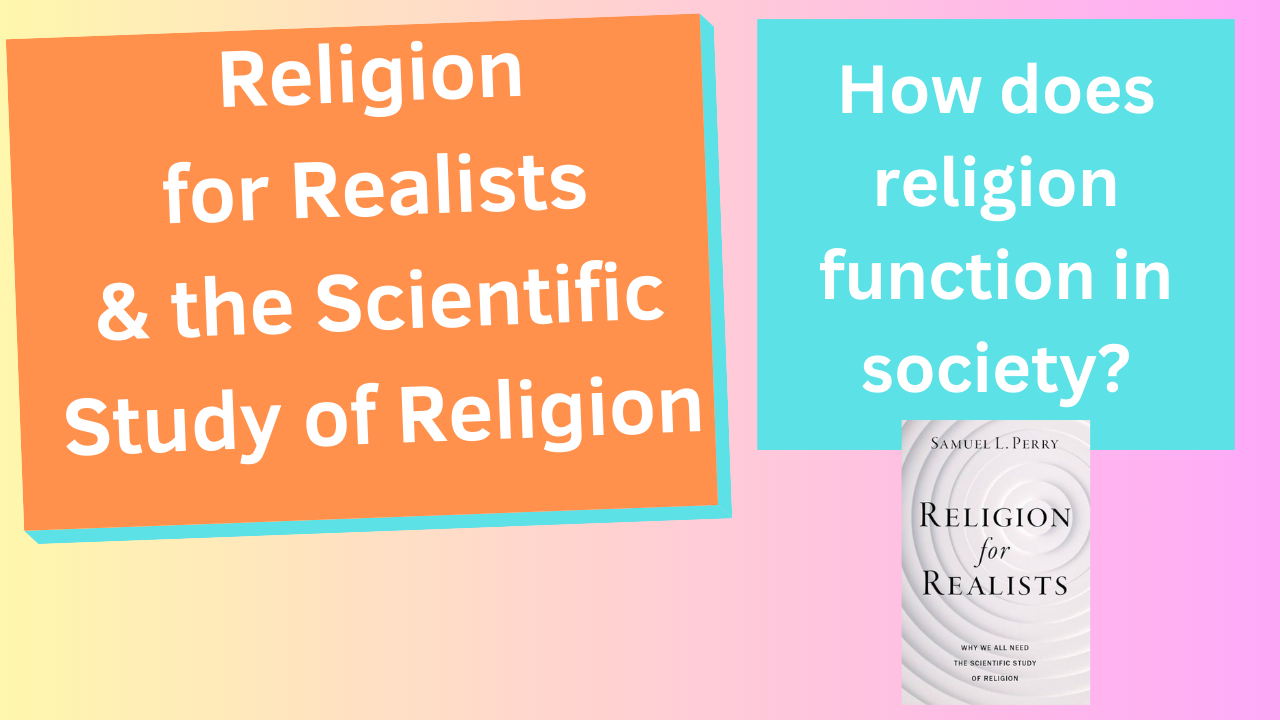03/19/2025 – Religion for Realists & the Scientific Study of Religion

Do we even know how religions work or what effects they have on society? Sam Perry says…probably not. Check this out. This is TenOnReligion.
Hey peeps, it’s Dr. B. with TenOnReligion. If you like religion and philosophy content one thing I really need you to do is to smash that sub button because it really helps out the channel. Also, if you find this content interesting drop me a Super Thanks here on YouTube. The transcript is available at TenOnReligion.com and new episodes are posted about every two weeks at noon, U.S. Pacific time, so drop me some views.
Last year in 2024 the University of Oklahoma sociologist Sam Perry published a book titled, Religion for Realists: Why We All Need the Scientific Study of Religion. This book argues that Anglophone Westerners often misunderstand much about how religion functions. It’s basically an argument about how the scientific study of religion should change our understandings of how religion functions in the West. This is a sociological book and sociology is the evidence-based study of groups of people. He defines “religion” as whatever subjective and objective realities human beings and their communities perceive and relate to as “religious.” The scientific study of religion is the systematic, evidence-based approach to understanding these subjective and objective realities of religion. We know that religion is real, at least in some sense, because it shapes the lives of billions of people and is a huge part of the social structures of society. There’s a lot of cool stuff going on in this book, so…let’s get into it.
This book is essentially arguing three main points which are all trying to correct misconceptions about how religion actually functions in society. The first is that the cognitive force in religion is not beliefs based on faith, but rather social identity and norms. Let’s explain. Human beings can be thrown into groups based on completely arbitrary criteria and almost immediately some human tendency would be activated which causes people to always favor their own group, assume the best about in-group members, and treat them as individuals. In contrast, the same people tend to be suspicious toward their competition, and foster prejudice towards any out-group members. Because of this known behavior in the way people function in groups, Perry concludes that religion isn’t fundamentally about faith, or even about the contents of one’s faith. At the level of cognitive and emotional processes, it’s about our relationship to in-group and out-group members. Religion is sacralized “us-ness.” It orients us within our in-group and it clothes “our people” and “how we do things” with transcendence and eternal, cosmic significance. This dynamic gives birth to myth, ritual, and theology. You see, Homo sapiens evolved within groups and it seems one of the reasons for Homo sapiens’ success as a species is our unique ability to cooperate with non-relatives by creating myths, stories, symbols, and ceremonies. Our collective rituals often involve coordinated physical activities that not only regulate our emotional well-being but also unite us against actual existential threats like enemies, competition, and the forces of nature. Studies that examine why devoutly religious persons are happier and healthier than other Americans find this is primarily due to the deep social relationships that come with consistent participation in religious communities. We are belongers before we are believers.
Now let’s look at this from analyzing a context. Religions provide a toolbox of teachings that are quite ready to be selectively applied to each context. For example, Perry asked Americans to place Jesus on the left-right ideological spectrum and found that the leading predictor of where Christians placed Jesus on the spectrum was their own ideological identity. Jesus just seems to look like us politically. But, Evangelicals’ commitment to theological beliefs can change quickly when their social group is either benefited or threatened. Devout Christians were on both sides of the Civil War in the mid-1800’s, and both sides of the civil rights movement in the mid-1900’s, each justifying either white supremacy or racial equality with their theology. We know through experimental evidence that people tend to approach actually reading the Bible with the same identity-lens, specifically that of our group. Americans have sorted politically to the point where party, ideological identity, religion, and other characteristics now thoroughly overlap and that our political identities increasingly organize our other social identities, including religious ones. This means that our definitions of what is “religious” in a positive sense are shaped by our own perceptions of group belonging and loyalty. All of our religious activities, meetings, rituals, myths, and so on serve the immediate purpose of marking who we are as a people, but also the ultimate purpose of socializing and reproducing our people to continue our way of life. So again, this is the first main point: the social sciences teach us human beings are cognitively fine-tuned for group life, and, consequently, group identity and norms, not “beliefs,” are the primary cognitive drivers of religious behavior.
The second main point is that the growth factor in religion is not ideas or doctrines, but population dynamics. The better metaphor for religious growth and decline isn’t a debate competition, or a marketplace, but an ecology. In an ecology, you win by producing more reproducing bodies of belongers with durable social identities and norms. Perry refers to this as evangelism the old-fashioned way: either birthing more people who will eventually internalize your religious group identity and norms or shipping in your people who will do the same. Population dynamics have contributed to there being enough unaffiliated persons in the population to where secularity is an increasing live option that people rarely switch back from once they embrace it. This then contributes to even more secularity. Despite all the theories about religious pluralism and science eroding religious faith by rendering it optional or intellectually problematic, religion has been remarkably resilient. Religious adherents with settled identities and norms who exist within some context where those identities and norms remain prioritized can develop cognitive work-arounds to deal with just about any dissonance. Yet, as pluralism increases, our religious boundaries erode, creating more interreligious marriages and other religiously integrated social contexts like schools, neighborhoods, workplaces, and sports teams. Consequently, each successive generation of citizens is less socially embedded within religious groups, leading to less emotional attachment, social pressure, ritual practice, and ultimately less attachment to the beliefs of the group. So, the second main point is that growth of religion has nothing to do with the ideas of that religion or its doctrines, but simply population dynamics.
The third main point in this book is that the change agent in religion is not individual obedience to a particular religion, but the social structures set up in any given society. What’s a social structure? “Social structures” are the rules and resources that are simultaneously both the consequence of social arrangements and behavior, and the medium through which those arrangements and behaviors are reproduced. It’s like this. Since we don’t have a robust inheritance of instincts like other animals, social structures are the ways we humans externalize our norms out into the world so that they organize, constrain, and reproduce our way of life. Put simply: we make social structures, but they also make us, whether we are aware of it or not. People can hold a remarkable amount of seemingly contradictory ideas in tension for the sake of keeping status and harmony within their group. Consequently, the evidence is far from clear that education, science, and religion are necessarily incompatible. They often work together. For example, it’s not that scientific knowledge causes people to disbelieve religion, but rather modernity has produced evidence-based methods of solving very practical problems that relentlessly fill the world with different structural alternatives to religion. And even more, modernity creates structural arrangements that don’t typically reverse. So, people aren’t going back to religion once something else fulfills a particular function in society.
To review, the three main points are, one, the cognitive force in religion is not beliefs based on faith, but rather social identity and norms. Two, the growth factor in religion is not ideas or doctrines, but population dynamics. And three, the change agent in religion is not individual obedience to a particular religion, but the social structures set up in any given society. Social science actually tells us a different picture than what most people expect. Now, the funny thing about science is that it has to be learned because it requires an unnatural and counterintuitive way of thinking. Our natural bent is toward confirmation bias. Confronting and addressing our biases is collectively redemptive. Not only do our particular research projects benefit when observers point out some flaws in our thinking and systems, we also learn something about ourselves. We learn ways we didn’t know we were being influenced. And now, one final note that he adds in the last chapter of this book. He states that among the most tragic casualties of American polarization in the past few decades has been Americans’ trust in intellectual leadership and institutions. The breakdown in trust of intellectual leadership and institutions is almost entirely localized to religious and political conservatives. They want to believe that religion is actually the exact opposite of what the social scientific evidence demonstrates. Yeah. This just goes to show you that we need the social scientific study of religion, maybe now more than ever.
So, what did you think about Sam Perry’s book, Religion for Realists? Leave a comment below and let me know what you think. And again, if this was in any way helpful, drop me a Super Thanks. Until next time, stay curious. If you enjoyed this, support the channel in the link below, please like and share this video and subscribe to this channel. This is TenOnReligion.
Samuel L. Perry, Religion for Realists: Why We All Need the Scientific Study of Religion, Oxford, 2024.


